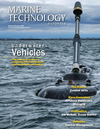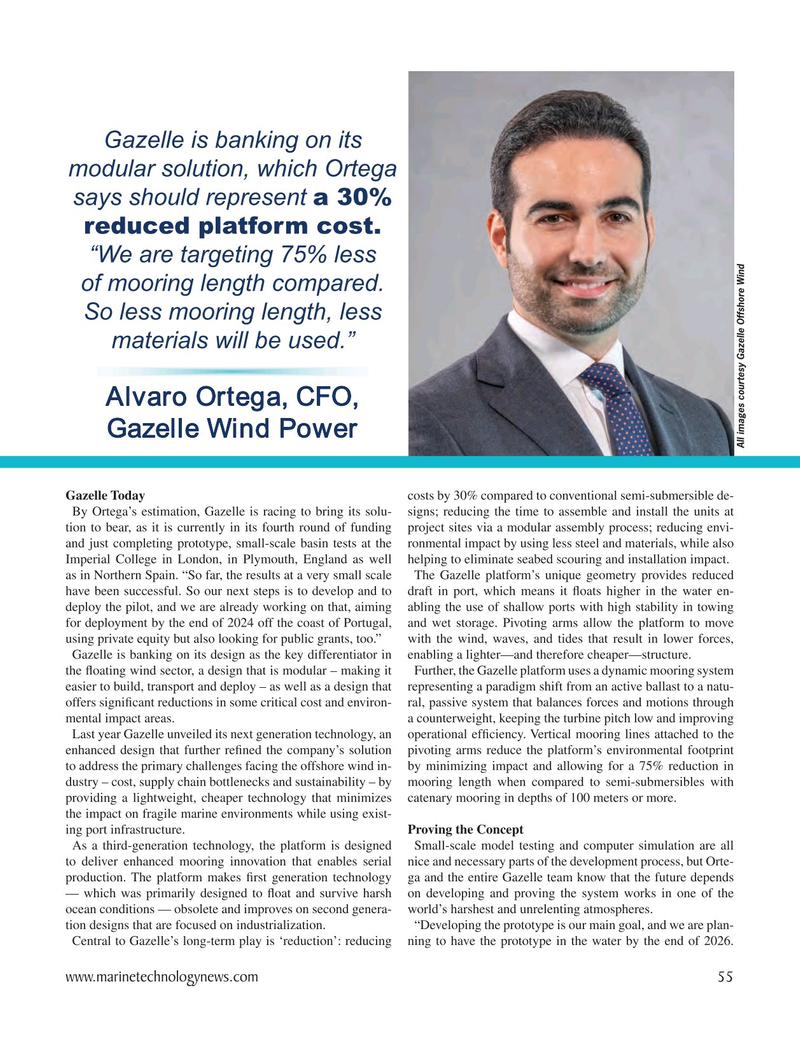
Page 55: of Marine Technology Magazine (January 2024)
Read this page in Pdf, Flash or Html5 edition of January 2024 Marine Technology Magazine
Gazelle is banking on its modular solution, which Ortega says should represent a 30% reduced platform cost. “We are targeting 75% less of mooring length compared.
So less mooring length, less materials will be used.”
Alvaro Ortega, CFO,
Gazelle Wind Power
All images courtesy Gazelle Offshore Wind
Gazelle Today costs by 30% compared to conventional semi-submersible de-
By Ortega’s estimation, Gazelle is racing to bring its solu- signs; reducing the time to assemble and install the units at tion to bear, as it is currently in its fourth round of funding project sites via a modular assembly process; reducing envi- and just completing prototype, small-scale basin tests at the ronmental impact by using less steel and materials, while also
Imperial College in London, in Plymouth, England as well helping to eliminate seabed scouring and installation impact.
as in Northern Spain. “So far, the results at a very small scale The Gazelle platform’s unique geometry provides reduced have been successful. So our next steps is to develop and to draft in port, which means it ? oats higher in the water en- deploy the pilot, and we are already working on that, aiming abling the use of shallow ports with high stability in towing for deployment by the end of 2024 off the coast of Portugal, and wet storage. Pivoting arms allow the platform to move using private equity but also looking for public grants, too.” with the wind, waves, and tides that result in lower forces,
Gazelle is banking on its design as the key differentiator in enabling a lighter—and therefore cheaper—structure.
the ? oating wind sector, a design that is modular – making it Further, the Gazelle platform uses a dynamic mooring system easier to build, transport and deploy – as well as a design that representing a paradigm shift from an active ballast to a natu- offers signi? cant reductions in some critical cost and environ- ral, passive system that balances forces and motions through mental impact areas. a counterweight, keeping the turbine pitch low and improving
Last year Gazelle unveiled its next generation technology, an operational ef? ciency. Vertical mooring lines attached to the enhanced design that further re? ned the company’s solution pivoting arms reduce the platform’s environmental footprint to address the primary challenges facing the offshore wind in- by minimizing impact and allowing for a 75% reduction in dustry – cost, supply chain bottlenecks and sustainability – by mooring length when compared to semi-submersibles with providing a lightweight, cheaper technology that minimizes catenary mooring in depths of 100 meters or more.
the impact on fragile marine environments while using exist- ing port infrastructure. Proving the Concept
As a third-generation technology, the platform is designed Small-scale model testing and computer simulation are all to deliver enhanced mooring innovation that enables serial nice and necessary parts of the development process, but Orte- production. The platform makes ? rst generation technology ga and the entire Gazelle team know that the future depends — which was primarily designed to ? oat and survive harsh on developing and proving the system works in one of the ocean conditions — obsolete and improves on second genera- world’s harshest and unrelenting atmospheres.
tion designs that are focused on industrialization. “Developing the prototype is our main goal, and we are plan-
Central to Gazelle’s long-term play is ‘reduction’: reducing ning to have the prototype in the water by the end of 2026. www.marinetechnologynews.com 55
MTR #1 (50-63).indd 55 1/31/2024 11:00:55 AM

 54
54

 56
56
